- Author
- A.N. Other
- Subjects
- History - general
- Tags
-
- RAN Ships
- None noted.
- Publication
- March 2022 edition of the Naval Historical Review (all rights reserved)
By LCDR David Jones RAN
Changing Times
From 2022, sailing has been removed from the initial training curriculum for new entry officers at RANC. Non-motorised small boat handling, sailing and rowing, has been a part of Initial Officer Training in the RAN since its beginnings in 1913. Even before that, during the many debates about the location for the College, one of the main considerations was suitability for small boat training. Knowing the sea, the wind and the tides was considered critical for most officers as they worked their way up through the ranks to hold responsibility at sea and many to become warship captains. Of course, motorised vessels had already reduced the skills required for good seamanship. Writing in 1931 about his early days in the RN, Creswell says:
Day or night, fair wind and weather, or otherwise, the Officer of the Watch of the sailing days after relieving the deck and taking in the wind, weather and sail situation, course, and so forth, would next turn over in his mind exactly what he would do if the cry of ‘Man overboard’ should be heard in his watch. How best to ‘round her up’ and get the lifeboat away – a problem of infinite variety, from running with stun-sails both sides at 12 or 13 knots to close hauled with two or three reefs in. Life depended on the right orders at the right time to reduce those huge areas of canvas and bring his ship under immediate and handiest command. Today, a turn of the handle on an engine-room telegraph is all that is required.(Close to the Wind, edited by Paul Thompson, Heinemann; London 1965. p142)
Since then of course technology has leapt ahead and we can apply almost unlimited thrust in any direction, instantaneously know our exact location, predict the weather, tides and currents with amazing accuracy, all from our climate controlled enclosed bridge. Whilst we still operate in the seascape, most would agree that mastery of its whims does not need to be so prominent in our general training. Others would argue that the additional benefits of leadership, teamwork, comradery, and resilience in a maritime context continue to speak for its relevance.
Despite the variety of opinions on this change of direction, many graduates of the college have significant and vivid memories of their adventures in the small boats and yachts of the college. This article outlines the history of college sailing from 1913 to 2021.
The early Years 1913 – 1930
Initially boatwork and sail training was conducted in ships’ boats, cutters whalers and skiffs that could be rowed, sailed and sometimes, when appropriately fitted, motored. The early college magazines feature the annual regatta, usually on the lagoon to the east of the Captain’s house, where rowing races were conducted in cutters, skiffs, sculls, gigs, and canoes. Although rowing was the main sporting use of small boats, sailing was a common means of propulsion for ships’ boats.
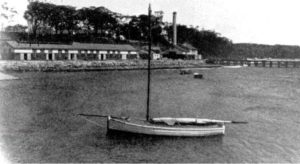
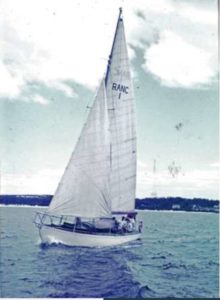
The following stories illustrate this: In 1916, the second year of the college at Jervis Bay, five sailors sailed a cutter to Huskisson. On the return trip a southerly buster hit them capsizing the boat. Erle Boyd swam three miles to shore and ran to the college for help. Two men drowned.
In the 1919 magazine there is an unexplained picture of Acid, a 6 m gaff rigged sailing vessel on the lagoon. Then in the 1924 magazine there is an account of a cadet sailing expedition to Bowen Island in cutters, monitored closely all day by the motorised college picket boat.
Cunningham records in his book on the history of the College that these ships’ boats provided cadets with knowledge of fleet equipment but were of little value for competitive yachting. (Work Hard Play Hard, LCDR I.J. Cunningham RAN AGPS, Canberra 1988. p72).
The earliest vessel that was specifically a college sailing yacht was the fishing smack Triton which was donated to the College by Mr. Frank Albert in 1924.
Mr. Albert’s son Otto was a member of the first RANC class and died of meningitis in 1914. Triton was an open boat and suitable only for enclosed waters: she served first at Jervis Bay and after 1930 at Hann’s Inlet, Victoria when the College moved to Flinders Naval Depot.
Hanns Inlet 1930 – 1958
Cunningham records: ‘Hanns Inlet was not a particularly attractive venue for boating. Apart from its shallowness and consequent susceptibility to tides, the wharf and boat sheds were about one mile from the college. All gear had to be carried there and back (at the double) before supper. If tidal conditions were poor, there would be little sailing and less enjoyment.’ (op cit p72).
In 1940, the college bought four new 14ft skiffs. These were lighter than the service skiffs, easier to handle and faster, and much more suited to sailing in Hann’s Inlet. (College Magazine, 1940, p31). The move to offshore sailing began in 1954, when the RAN bought the yacht Tam O’Shanter for £3,400.
Tam-O, as she was popularly known, was a 5.5 ton 33 ft timber sailing sloop designed and built in 1951 by Ernest Digby in Melbourne. She was bought to enter the Sydney to Hobart race and her purchase coincided with the formation of the RANC Sailing Club. She sailed in the 1954 and 1955 Sydney to Hobart Yacht races, but after the notorious 1956 race was declared unsuitable for further ‘Hobarts’.
Ocean sailing continued however, in the 28 ft Four Winds that had also competed in the 1956 Hobart race with a college crew. The yacht belonged to an honorary member of the newly formed RANC Sailing Club, Mr Stanley W. Gibson. This small yacht bearing sail number ‘RANC SC 3’ competed again with a college crew in 1957 but after the college moved back to Jervis Bay in 1958 the association with Four Winds ended.
Jervis Bay 1960 – 1970s
Triton was retired in 1957 as uneconomical to maintain and in 1960 after the College returned to Jervis Bay, Mr. Albert again generously donated a replacement, Sabrina, a timber 24 ft Derwent class inshore yacht. She was given the number RANC 4.
After some major structural work, Tam O’Shanter returned to compete in the 1959 and 1960 Sydney to Hobart races. Today, she is on the Australian Register of Historic Vessels and in 2017 was being restored in Sydney after being rescued from demolition in 2013.
Continuing the line of College sailing yachts, the timber Franklin II was built at Garden Island in 1962 and, whilst intended to take over the role of the post-war Navy yachts Schwalbe and Mavis in Sydney, she would be re-purposed to take over from Tam O’Shanter at the College in Jervis Bay.
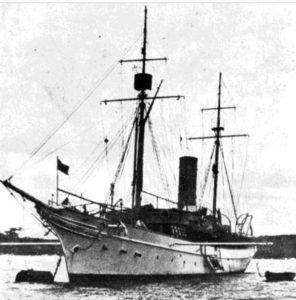
Franklin is a name long associated with the college. HMAS Franklin I was a 44 m steam yacht displacing 350 tons, originally built for private owners in Scotland in 1906 as Adele. She was purchased by the Commonwealth Government for £10,750 from the estate of Henry Dutton of Kapunda, South Australia and named in honour of Sir John Franklin, Naval Officer, explorer and one-time Governor of Tasmania. After being sold in 1922 and serving in New Guinea, she was again commissioned as HMAS Adele in 1939 but ran aground and sank in 1943 off the Port Kembla breakwater, where the wreck still lies.
Franklin II was of a class designed by Morgan Giles for the Royal Navy as an easily handled conventional yacht for cadet training, not for ocean racing. This was illustrated vividly in 1965 when the aging Tam O’Shanter entered its last Sydney to Hobart Race and beat Franklin by nearly 6 hours! Franklin II cost £20,000 to build, was 43 ft long, had a displacement of 9.25 tons and a racing crew of seven or eight.
The design was relatively old and was modified for its Australian role, resulting in its ocean racing handicap being not really competitive against contemporary Australian designs. In one of her earliest races, the 1963 Cabbage Tree Island race, she was nearly lost, being dismasted and dragging her anchor to within half a mile of the surf line at Terrigal Beach. She was then fitted with a shorter aluminium mast, stronger rigging, a better engine and completed the Sydney to Hobart Yacht Race every year from 1965 to 1973.
During this time sail training remained an important part of the RANC’s curriculum. In addition to the yachts, dinghies played a prominent role. Bosun dinghies had been acquired to replace older 14 ft Island class dinghies.
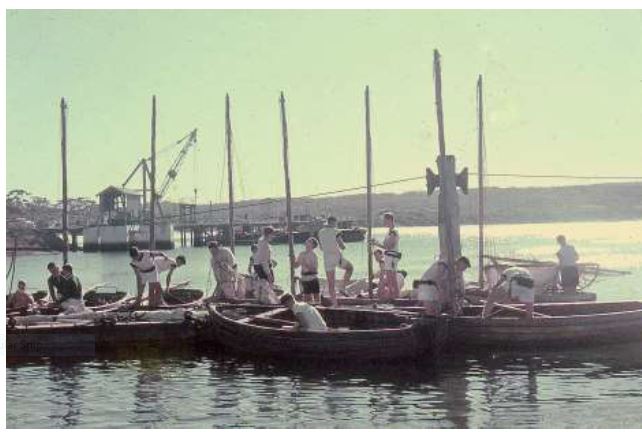
Also in the early 1960s small catamaran sailing was becoming popular and the college built a 12 ft cat, using ships funds. The Royal New Zealand Navy also gifted the College two small catamarans, named Lord Fury and Even Stevensafter New Zealand owned, Melbourne Cup winning horses in 1961 and 1962.
In 1986 Tasars replaced the Bosuns across the ADF and in 2018, ten new RS Quest 4.3 m polyethylene dinghies were purchased and the Tasars distributed to cadet units. The Quest dinghies will continue be used recreationally at the College.
In 1972 the College received two Endeavour 24s (Callala and Currarong) to bridge the size gap between the dinghies and the larger ocean-going yachts. In 1976 two more Endeavours (Cararma and Currumbene) were purchased to give each division a yacht to maintain.
Ocean Racing from the 1980s
In the later 1970s and 1980s Franklin was maintained at HMAS Creswell and refitted from time to time at Garden Island, however she was considered past her ocean racing days. In 1983 and 1984 the Navy leased Onya and Pascha respectively and RANC crewed them for the Sydney to Hobart.
Following this the Navy purchased five Swarbrick IIIs for its sail training and ocean racing vessels These were all named after ships of the First Fleet with their ‘home’ naval base as a suffix. (Lady Penryn of Nirimba, Scarborough and Charlotte of Cerberus, Friendship of Leeuwin, and Alexander of Creswell). Alexander arrived at Creswell in late 1984 and entered the Sydney to Hobart Yacht Race regularly from 1985 until 2000, missing only two years.
Franklin II was increasingly expensive to maintain, however she made a brief attempt to re-enter ocean racing in 1988, Australia’s bicentennial year and the 75th year of the RANC, when Creswell volunteers put in a considerable effort to get her certified for the Sydney to Hobart. She started but was forced to retire. Navy yachts Alexander and Lady Penryncompleted the same race. This brought to an end the navy career of Franklin II. Around 1991 it was sold to the Australian Army who were prepared to refit her for the Sydney to Hobart again. The Army renamed her Rising Sun along with fitting her with a green and gold spinnaker adorned with that emblem. She completed the 1993 and 1994 races and in 1995 she withdrew in Bass Strait with a sprung plank.
The Army sold the boat to a private owner who had her slipped in Snails Bay, Sydney. After several changes of owner, she was bought by a boat builder named Peter Schwartz of Caringbah, Sydney, who has rebuilt her with great care and skill.
In April 2021 the restored Franklin called in to her former home at Creswell, Jervis Bay, to be presented with her original builder’s plate and plaques. Franklin rounded the breakwater in company with navy yachts Navy One (FranklinIII), Friendship and Scarborough.
On arrival at Creswell, Franklin was met by the Commanding Officer, Captain Warren Bairstow, AM, CSC, RAN and the Commanding Officer of the Royal Australian Naval College, Commander David Shirvington RAN. They were accompanied by a host of New Entry Training Officers from the current entry as well as other interested staff and employees. Mr Schwartz was presented with the original Franklin II builder’s steel plaque and plaques from the yacht’s ten Sydney to Hobart entries.
In the early 2000s, the Navy bought a steel sail training yacht called Salthorse. Run by Defence Maritime Services (DMS), this sturdy and well-equipped ketch was used for many years for sail training, adventure training and leadership exercises. It had accommodation for four crew and 10 trainees.
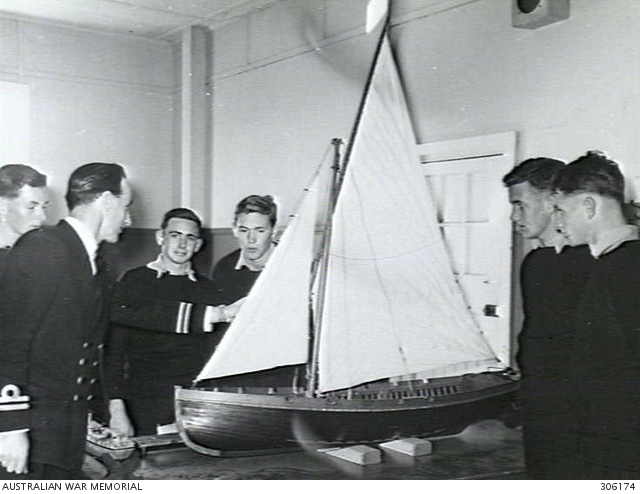
In 2017, Navy purchased a ‘Beneteau First 40’, the former Sydney to Hobart yacht Outlaw, to replace the previous RANC sail training yacht Alexander of Creswell. Alexander was wrecked in June 2016, when the pontoon to which she was secured broke free during a fierce storm and was driven onto Seaman’s Beach at Creswell. The new Beneteau arrived at Creswell on the evening of 18 May 2017 after an uneventful passage from Sydney that day. The Beneteau First 40 is a 7536 kg displacement fractional sloop designed by Bruce Farr, with fibreglass hull with fin bulb and spade rudder. It carries 3000 kg of ballast and a standard sail area of 80 sq metres.
Outlaw (originally Lunchtime Legend), was built in 2010 and was renamed Franklin. She was the third boat to bear that name as the continuation of a traditional name for RAN College vessels. In 2019 she was given a fourth name Navy One prior to her competing in the 2019 Sydney to Hobart race. It was the first time Navy had entered the race since 2000. Navy One completed the 2019 Sydney to Hobart race in 3 days 16 hours and 16 minutes beating the previous record of Alexander of 4 days 5 hours 50 minutes set in 1991.
After the race was cancelled in 2020, Navy One entered again in 2021 completing the difficult race in 5 days 14 hours 52 minutes. The longest time for a Navy entrant was in 1956 when Four Winds took 8 days 12 hours 18 minutes to reach Hobart.
Summary
Late in 2021, the remaining and aging Swarbrick IIIs were sold, leaving the Beneteau as the sole navy ocean-going yacht. This marks the end of the era of formal and curricular Naval College yachting although the sport of sailing is still available to those interested through Navy One and the Navy Sailing Association in Sydney and on the remaining Quest dinghies at the college.
Whilst change is inevitable, through change we need to make sure that essential skills are not sacrificed.
The challenge therefore is to ensure that the effective and relevant learning and experience achieved through sail training over the years continues to be achieved to meet the evolving challenges of the future.
A number of navies still retain sail training ships and regard the testing rigours of cordage and canvas and exposure to the harsh elements of wind and tide as important to the development of young seafarers. However, in an age of electronic simulation in controlled work environments there is reduced call for practical applications. It will be interesting to see how these ‘End of an Era’ changes evolve. Perhaps the term ‘sailors’ will shortly disappear from our lexicon.





